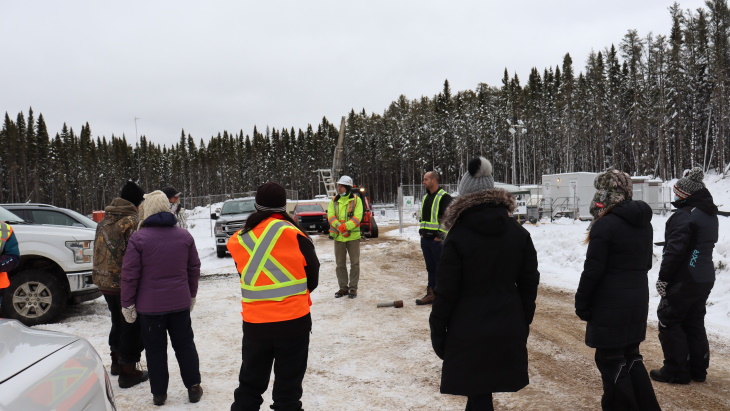NUKE NEWS
30 November 2021
Nuclear energy offers a "golden opportunity" to create a cleaner and more equitable world, World Nuclear Association Director General Sama Bilbao y León said today at the World Nuclear Exhibition in Paris. However, she noted there are three major challenges hindering the nuclear industry in making its full potential contribution towards sustainable development and combatting climate change: financing, perception and regulation
.jpg?ext=.jpg)
Bilbao y León said about 440 nuclear power reactors are "quietly operating in the background - out of sight and out of mind - providing people across the world with always-on, inexpensive, non-polluting and reliable energy."
She added that, so far this year, over 5 GW of new nuclear generating capacity has been brought online across the world, in China, India, Pakistan and the UAE. Meanwhile, construction has started on a further 6 GW of capacity. "The nuclear sector is gathering quite a bit of momentum," she said.
Extending the life of the current fleet of reactors as long as feasible is vitally important, she said. "We have seen positive movement on this front, particularly in the USA, where nearly 20 reactors have been saved from needless premature closure in the last five years - closures that would not only increase greenhouse gas emissions, but also undermine energy independence and result in lethal air pollution ... and leave behind many communities whose economy depends on these units."
Meeting the 1.5°C temperature rise target in a cost-effective and socially equitable manner will require the rapid deployment of much more nuclear energy, Bilbao y León said. "Nuclear power enables rapid decarbonisation on a massive scale, and it has the track record to prove it."
"Nuclear technologies will play a major role in making possible a net-zero world of abundant energy for everyone, generating electricity for large grids and small communities alike, providing district heating and cooling, supplying process heat to industry, producing hydrogen, and so much more," she said. "Because nuclear energy is the only energy source that can produce low-carbon electricity and low-carbon heat, it can be a game changer for the deep decarbonisation of the entire global economy."
For nuclear energy to play a significant role to meet the decarbonisation and sustainable development needs of the world, more than 1200 GWe of nuclear generation must be installed by 2050. This means the construction of 30 new reactors annually. "We can do it," Bilbao y León said. "We have done this before, but we have not yet reached that level today."
She said the nuclear industry urgently needs to lay down the human, physical, commercial and institutional infrastructures that will enable it to "truly scale up fast to meet the urgent and massive decarbonisation needs.
"Going further yet, we need to accelerate the development and deployment of small modular reactor (SMRs) and advanced nuclear technologies. SMRs and advanced nuclear projects will play an important role in further diversifying the nuclear sector, and bringing nuclear to new markets and applications."
Challenges to overcome
However, Bilbao y León said the nuclear industry must "build on the momentum of today to remove the remaining barriers that nuclear energy faces." These, she said, are financing, perception and regulation.
With regards to financing, she said it is essential the industry ensure nuclear power projects are included in the various ESG (environment, social and governance) finance frameworks and sustainable finance taxonomies being developed across the world.
"The global nuclear sector needs to continue to work towards ensuring that all these green financing classifications and frameworks - which will be used to build a more sustainable tomorrow - are based on scientific and technology-neutral methodologies."
She said it is also imperative to develop financial, contractual and market approaches that help align the characteristics of a nuclear project with the needs and priorities of private investors. "Indeed, nuclear power should be a natural choice for any investor with a long-term horizon, such as pension funds."
There has been growing recognition amongst policy makers and the public of the low-carbon attributes and high reliability of nuclear power, Bilbao y León noted. "But let's be clear on this: recognition is not enough. We don't want nuclear energy to be the option of last resort ... we want it to be the first choice.
"Beyond achieving decarbonisation in high-income countries, there are so many powerful stories that the nuclear community should tell, stories that will be incredibly powerful in changing public perception towards nuclear technologies. Such as painting the picture of a world in which the economies of today's developing countries thrive thanks to a reliable supply of abundant, clean and cheap electricity."
On the issue of regulation, she said the industry urgently needs to address the licensing of reactor designs across national borders. "There can be no doubt that the nuclear industry is being held back by national approaches to licensing and regulation, turning what should be an efficient series of nth-of-a-kind projects with significant learning curves, into a never-ending series of first-of-a-kind ones, with its many - and well-known - drawbacks," Bilbao y León said. "This creates unnecessary uncertainty and risk to the deployment of new reactors.
"The world has changed, and we must change with it ... Now more than ever it is essential for industry, regulators and governments to work together to align national regulatory approaches and streamline the international licensing process."
She said the future for nuclear power has "not looked brighter in many years, but it is up to us to capitalise on the current momentum and make the absolute most of this opportunity. Game on for nuclear!"
Researched and written by World Nuclear News
South Australian site to host national radwaste facility
29 November 2021
Napandee near Kimba in South Australia has been formally selected as the location of a national low and medium-level radioactive waste facility. Under the relevant legislation, the declaration today by Australia's Minister for Resources and Water Keith Pitt has the effect of the Commonwealth acquiring about 211 hectares of land for the purpose of hosting the National Radioactive Waste Management Facility (NRWMF).
.jpg?ext=.jpg) The Napandee nominated site (Image: Australian Department of Industry, Science, Energy and Resources)
The Napandee nominated site (Image: Australian Department of Industry, Science, Energy and Resources)
Following a call for site nominations in 2015, Napandee was voluntarily nominated in 2017 by its landowner as a possible site to host the facility.
In September 2020, an Australian Senate committee recommended that Parliament pass legislation that would make Napandee the preferred site for the facility. The bill would establish a national facility to permanently dispose of low-level radioactive waste and temporarily store intermediate-level radioactive waste by amending the National Radioactive Waste Management Act 2012 to, amongst other things, specify the site selected and enable the acquisition of additional land for the facility.
On 11 August, Pitt announced his decision to issue notices of an intention to declare Napandee as the proposed site for the facility. Following a period of further consultation, the Australian government today confirmed the site has been selected to host the NRWMF.
Construction of the facility will begin after detailed designs, technical and heritage studies are completed. The facility delivery and operation will be managed by the Australian Radioactive Waste Agency (ARWA) in Adelaide. The application and approval processes are expected to take a number of years to be completed.
ARWA noted today's announcement "is another step towards a AUD31 million (USD22 million) Community Development Package to support the local host community."
"I'm pleased to confirm we have reached a major milestone in our work to deliver this national facility, and a solution that has eluded consecutive governments for more than 40 years," Pitt said. "This new facility will create 45 new, permanent jobs in the local Kimba community, in fields as diverse as security, administration, environmental monitoring, scientific services, health and safety."
Australia does not produce nuclear energy but has a long experience of operating research reactors and producing radioisotopes for use in medicine, research and industry. According to World Nuclear Association, the country produces about 45 cubic metres of mostly low-level radioactive waste per year from the manufacture and use of radioisotopes. This waste is currently stored at over a hundred sites around the country, including science facilities, hospitals and universities. Six volunteered sites were shortlisted for a national repository for both categories of waste, and after a process lasting some 28 years Napandee was last year identified by the government as the preferred site for the low-level waste facility.
The Australian Nuclear Science and Technology Organisation (ANSTO) said the development of a purpose-built, national facility is "crucial to ANSTO and its nuclear medicine and research activities, with more than 90% of the waste produced in Australia being linked to ANSTO's nuclear medicine production."
Pitt said: "Nuclear medicine is used in the diagnosis of a variety of heart, lung and muscular-skeletal conditions as well as the treatment of specific cancers, and a by-product of its production is low-level radioactive waste. Along with the benefits comes a responsibility to manage the by-products. Without a facility like this, we can't enjoy the benefits from vital nuclear medicines on an ongoing basis.
"This facility will underwrite Australia's nuclear medicine supplies, and support good, permanent, full-time jobs and a brand new industry in Kimba, for generations."
ARWA was set up in July 2020 to manage all Australia's radioactive waste and to lead the process to deliver the NRWMF. It will also lead a separate process to site a facility to permanently dispose of the country's intermediate-level waste. This will likely be a deep geological facility in a different location.
Spanish uranium project denied authorisation
29 November 2021
Spain's Ministry for Ecological Transition and the Demographic Challenge (MITECO) has rejected Berkeley Energia's authorisation to build a uranium processing plant at the company's Salamanca project in western Spain. The company has questioned the legality of the decision.
.jpg?ext=.jpg) (Image: Pixabay)
(Image: Pixabay)MITECO's decision follows an unfavourable report for the grant of the Authorisation for Construction for the plant as a radioactive facility - known as NSCII - which was issued by Spain's Nuclear Safety Council (Consejo De Seguridad Nuclear, CSN) in July. Later the same month, Berkeley submitted a supplementary Improvement Report and corresponding arguments addressing all the issues raised by the CNS and requested a reassessment. Further documentation was submitted to MITECO in early August, when the company again restated the project's compliance with all requirements for the NSC II to be awarded.
"As previously reported, Berkeley strongly refutes the NSC's assessment and, in the company's opinion, the NSC has adopted an arbitrary decision with the technical issues used as justification to issue the unfavourable report lacking in both technical and legal support," the company said on 26 November, after MITECO formally notified the company of its decision.
Berkeley requested from MITECO access to the files associated with the relevant construction and dismantling and closure authorisations for previous radioactive facilities at La Haba (Badajoz) and Saelices El Chico (Salamanca), which are owned by Enusa Industrias Avandas SA, "to verify and contrast the conditions approved by the competent administrative and regulatory bodies for other similar uranium projects in Spain. Based on those files, it said, "it is clear that Berkeley, in its NSC II submission, has been required to provide information that does not correspond to: (i) the regulatory framework, (ii) the scope of the current procedural stage (i.e. at the NSC II stage), and/or (iii) the criteria applied in other licensing processes for similar radioactive facilities). Accordingly, the company considers that the NSC has acted in a discriminatory and arbitrary manner when assessing the NSC II application for the Salamanca project."
"In Berkeley's strong opinion, MITECO has rejected the company's NSC II application without following the legally established procedure, as the Improvement Report has not been taken into account and sent to the NSC for its assessment, as requested on multiple occasions by the company," it said.
"In this regard, the company believes that MITECO have infringed regulations on administrative procedures in Spain, as well as Berkeley's right of defence, which would imply that the decision on the rejection of the company's NSC II application is not legal."
Berkeley said it will "immediately consider the range of legal options available to it in relation to the adverse resolution by MITECO."
The Salamanca project has 59.8 million pounds U3O8 (23,000 tU) of measured and indicated resources as well as inferred resources of 29.6 million pounds of U3O8. According to a definitive feasibility study published by Berkeley in 2016, it would be capable of producing an average of 4.4 million pounds of uranium per year at a cash cost of USD13.30 per pound over an initial ten-year period.
Initial on-site infrastructure work began in 2016, and work began on road realignment and a power line upgrade ahead of main construction. The Municipality of Retortillo in 2020 issued Berkeley Energia a land use permit, known as an Urbanism Licence, for construction works at the project, leaving the NSC II as the only outstanding approval required for full construction to begin.
Researched and written by World Nuclear News
.jpg?ext=.jpg) NWMO has retrieved 6 km of rock cores from the Ignace area (Image: NWMO)
NWMO has retrieved 6 km of rock cores from the Ignace area (Image: NWMO) A tour to the Ignace borehole sites in November 2021 (Image: NWMO)
A tour to the Ignace borehole sites in November 2021 (Image: NWMO).jpg?ext=.jpg) Cernavoda has two operational reactors, and two that are only partly constructed (Image: Nuclearelectrica)
Cernavoda has two operational reactors, and two that are only partly constructed (Image: Nuclearelectrica)









